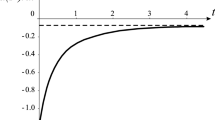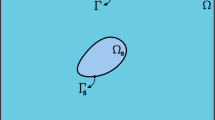Abstract
We consider in this work the numerical approximations of the two-dimensional steady potential flow around a body moving in a liquid of finite constant depth at constant speed and distance below a free surface. Several vertical segments are introduced as the upstream and the downstream artificial boundaries, where a sequence of high-order local artificial boundary conditions are proposed. Then the original problem is solved in a finite computational domain, which is equivalent to a variational problem. The numerical approximations for the original problem are obtained by solving the variational problem with the finite element method. The numerical examples show that the artificial boundary conditions given in this work are very effective.
Similar content being viewed by others
REFERENCES
Adams, R. A. (1975). SobolevSpaces, Academic Press, New York.
Bao, W., and Wen, X. (2000). The artificial boundary conditions for computing the flow around a submerged body. Comput.Methods Appl.Mech.Engrg. 188, 473–482.
Doctors, L. J., and Beck, R. F. (1987). Convergence properties of the Neumann-Kelvin problem for a submerged body. J.Ship.Res. 31, 227–234.
Engquist, B., and Majda, A. (1977). Absorbing boundary conditions for the numerical simulation of waves. Math.Comp. 31 629–651.
Feng, K. (1984). Asymptotic radiation conditions for reduced wave equations. J.Comput.Math. 2, 130–138.
Givoli, D. (1992). Numerical Methods for Problems in Infinite Domains, Elsevier, Amsterdam.
Goldstein, C. I. (1982). A finite element method for solving Helmholtz type equations in waveguides and other unbounded domains. Math.Comp. 39, 309–324.
Hagstrom, T. M., and Keller, H. B. (1986). Exact boundary conditions at artificial boundary for partial differential equations in cylinders. SIAM J.Math.Anal. 17, 322–341.
Hagstrom, T. M., and Keller, H. B. (1987). Asymptotic boundary conditions and numerical methods for nonlinear elliptic problems on unbounded domains. Math.Comp. 48, 449–470.
Halpern, L., and Schatzman, M. (1989). Artificial boundary conditions for incompressible viscous flows. SIAM J.Math.Anal. 20, 308–353.
Han, H., and Bao, W. (1996). An artificial boundary condition for two-dimensional incompressible viscous flows using the method of lines. Int.J.Numer.Methods Fluids 22, 483–493.
Han, H., and Bao, W. (1995). An artificial boundary condition for the incompressible viscous flows in a no-slip channel. J.Comput.Math. 13, 51–63.
Han, H., Lu, J., and Bao, W. (1994). A discrete artificial boundary condition for steady incompressible viscous flows in a no-slip channel using a fast iterative method. J.Comput.Phys. 114, 201–208.
Han, H., and Wen, X. (2000). The global artificial boundary conditions for numerical simulations of the flow around a submerged body, Technique Report No. 64, Department of Mathematical Sciences, Tsinghua University, Beijing, China.
Han, H., and Wu, X. (1985). Approximation of infinite boundary condition and its application to finite element method. J.Comput.Math. 3, 179–192.
Han, H., and Wu, X. (1992). The approximation of exact boundary condition at an artificial boundary for linear elastic equation and its application. Math.Comp. 59, 21–27.
Malmliden, J. F., and Petersson, N. A. (1996). A fast iterative method to compute the flow around a submerged body. Math.Comp. 65, 1067–1083
Nakos, D. E., and Sclavounos, P. D. (1990). On steady and unsteady ship wave patterns. J.Fluid Mech. 215, 263–288.
Petersson, N. A. (1992). A numerical method to calculate the two-dimensional flow around an underwater obstacle. SIAM J.Numer.Anal. 29, 20–31.
Petersson, N. A., and Malmliden, J. F. (1993). Computing the flow around a submerged body using composite grids. J.Comput.Phys. 105, 45–57.
Whitham, G. B. (1974). Linear and Nonlinear Waves, Wiley InterScience, New York. 286
Author information
Authors and Affiliations
Rights and permissions
About this article
Cite this article
Han, H., Wen, X. The Local Artificial Boundary Conditions for Numerical Simulations of the Flow Around a Submerged Body. Journal of Scientific Computing 16, 263–286 (2001). https://doi.org/10.1023/A:1012817627722
Issue Date:
DOI: https://doi.org/10.1023/A:1012817627722




